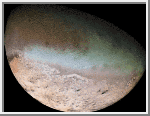 Triton
Triton Triton
TritonNeptune I

Triton [TRY-tun] is the largest moon of Neptune, with a diameter of 2,700 kilometers (1,680 miles). It was discovered by William Lassell, a British astronomer, in 1846 scarcely a month after Neptune was discovered. Triton is colder than any other measured object in the Solar System with a surface temperature of -235° C (-391° F). It has an extremely thin atmosphere. Nitrogen ice particles might form thin clouds a few kilometers above the surface. The atmospheric pressure at Triton's surface is about 14 microbars, 1/70,000th the surface pressure on Earth.
Triton is the only large satellite in the solar system to circle a planet in a retrograde direction -- in a direction opposite to the rotation of the planet. It also has a density of about 2.066 grams per cubic centimeter (the density of water is 1.0 gram per cubic centimeter). This means Triton contains more rock in its interior than the icy satellites of Saturn and Uranus do. The relatively high density and the retrograde orbit has led some scientists to suggest that Triton may have been captured by Neptune as it traveled through space several billion years ago. If that is the case, tidal heating could have melted Triton in its originally eccentric orbit, and the satellite might even have been liquid for as long as one billion years after its capture by Neptune.
Triton is scarred by enormous cracks. Voyager 2 images showed active geyser-like eruptions spewing nitrogen gas and dark dust particles several kilometers into the atmosphere.

Discovered by ............................... William Lassell Date of discovery ...................................... 1846 Mass (kg) .......................................... 2.14e+22 Mass (Earth = 1) ................................. 3.5810e-03 Equatorial radius (km) ................................ 1,350 Equatorial radius (Earth = 1) .................... 2.1167e-01 Mean density (gm/cm^3) ................................. 2.07 Mean distance from Neptune (km) ..................... 354,800 Rotational period (days) ........................... -5.87685 Orbital period (days) .............................. -5.87685 Mean orbital velocity (km/sec) ........................ -4.39 Orbital eccentricity ................................. 0.0000 Orbital inclination .................................. 157.35° Escape velocity (km/sec) ............................... 1.45 Visual geometric albedo ................................. 0.7 Magnitude (Vo) ........................................ 13.47 Mean surface temperature ............................. -235°C

 Animations of Triton
Animations of Triton
 Triton
(GIF, 466K;
JPEG, 161K;
caption)
Triton
(GIF, 466K;
JPEG, 161K;
caption)
Voyager 2
obtained this color image of Neptune's
large satellite Triton during its close flyby on Aug. 25, 1989.
The large south polar cap at the bottom of the image is
highly reflective and slightly pink in color; it might consist of a
slowly evaporating layer of nitrogen ice deposited during the
previous winter. From the ragged edge of the polar cap northward,
the satellite's face is generally darker and redder in color.
This coloring may be produced by the action of ultraviolet light
and magnetospheric radiation
upon methane in the atmosphere and
surface. Running across this darker region, approximately
parallel to the edge of the polar cap, is a band of brighter
white material that is almost bluish in color. The underlying
topography in this bright band is similar; however, to that in the
darker, redder regions surrounding it.
(Courtesy NASA/JPL)
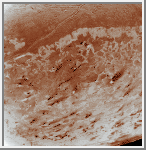 South Pole
(GIF, 298K)
South Pole
(GIF, 298K)
This high resolution image of Triton was obtained by Voyager 2
on August 25, 1989. It shows the moon's south polar cap. One
of the unusual aspect of this image is the dark streaks in the
images. Perhaps they were made by geyser-like eruptions of
nitrogen. The geyser eruptions could have carried darker
materials from the crust. The light regions probably consist
of layers of nitrogen.
(Credit: Calvin J. Hamilton)
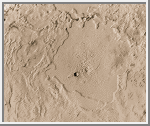 Plain of Ice
(GIF, 406K)
Plain of Ice
(GIF, 406K)
This view of Triton shows a plain of ice. It was probably formed by
eruptions of water or a water-ammonia slurry. It seems to fill the
remains of an ancient impact basin.
(Credit: Calvin J. Hamilton)
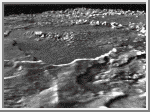 Triton in 3D
(JPEG, 95K;
caption)
Triton in 3D
(JPEG, 95K;
caption)
This is a computer-generated perspective rendering of one of
the caldera-like
depressions on Triton, as it would appear if
viewed from the northeast. The image was obtained
Aug. 24, 1989, when the Voyager spacecraft was about
181,800 kilometers
(112,900 miles) from Triton.
The caldera floor shown in this image is approximately
200 kilometers (120 miles) in
diameter. It is extremely flat and probably was formed by the
volcanic eruption of ice lavas of very low viscosity. The
bench visible in the foreground may be a remnant of earlier
flooding to a level about 200 meters (600 feet) higher than
the present caldera floor.
(Courtesy NASA/JPL)
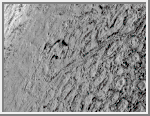 Surface of Triton
(GIF, 327K;
JPEG, 89K)
Surface of Triton
(GIF, 327K;
JPEG, 89K)
This is one of the most detailed views of the surface
of Triton taken by Voyager 2 on its flyby of the large satellite of
Neptune early in the morning of August 25, 1989. The picture was taken from a distance
of 40,000 kilometers (25,000 miles), the frame is about 220 kilometers (140
miles) across and shows details as small as 750 meters (0.5 miles). Most
of the area is covered by a peculiar ladnscape of roughly circular
depressions separated by rugged ridges. This type of terrain, which covers
large tracts of Triton's northern hemisphere, is unlike anything seen
elsewhere in the solar system. The depressions are probably not impact
craters: They are too similar in size and too regularly spaced. Their
origin is still unknown, but may involve local melting and collapse of the
icy surface. A conspicuous set of grooves and ridges cuts across the
landscape, indicating fracturing and deformation of Triton's surface. The
rarity of impact craters suggests a young surface by solarsystem
standards, probably less than a few billion years old.
(Courtesy NASA/JPL)
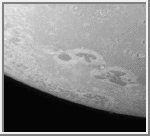 Dark Areas on Triton
(GIF, 99K;
JPEG, 7K)
Dark Areas on Triton
(GIF, 99K;
JPEG, 7K)
Voyager 2 acquired this black and white image of
Triton during the night of August 24-25, 1989.
Triton's limb cuts obliquely across the middle of the image. The field of
view is about 1,000 km (600 miles) across. Three irregular dark areas,
surrounded by brighter material, dominate the image. Low-lying material
with intermediate albedo occupies the central area, and fresh craters
occur along the right margin. Sub-parallel alignment of linear patches of
dark material shown in the lower and left part of the image suggests that
the patches are structurally controlled.
(Courtesy NASA/JPL)

